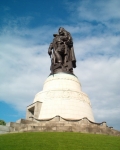Soviet War Memorial
Archaeology »
Archaeological Monuments » Soviet War Memorial
Soviet War Memorial - Germany
Soviet War Memorial is located in Treptower Park,Berlin.
Soviet War Memorial monument was established on 1949.
Primary threats to Soviet War Memorial :
The focus of the ensemble is a monument by Soviet sculptor Yevgeny Vuchetich: a 12-m tall monument of a Soviet soldier with a sword holding a child, standing over a broken swastika. Vuchetich's inspiration for the monument was Soviet soldier Nikolai Masalov (1922-2004).
Historical facts of Soviet War Memorial :
- The Soviet War Memorial, also known as the Soviet War Memorial in Tiergarten, is a significant historical monument located in Berlin, Germany. It serves as a tribute to the Soviet soldiers who lost their lives during World War II, particularly during the Battle of Berlin in 1945. The memorial holds profound symbolic and emotional importance, representing the enduring relationship between Germany and Russia, and stands as a reminder of the devastating impact of war.
- The Soviet War Memorial was designed by Soviet architect Yakov Belopolsky and was built between 1946 and 1949. It is situated in the Tiergarten, a large park in central Berlin, near the Brandenburg Gate and the Reichstag building. The location was chosen to mark the site where the Soviet soldiers fought some of the most intense battles during the final stages of World War II.
- The central element of the memorial is a large statue of a Soviet soldier holding a child in his left arm and wielding a sword with his right hand. The soldier's expression is resolute and determined, signifying the triumph of good over evil and the protection of the innocent. The statue is made of bronze and stands atop a massive stone pedestal, which includes a bronze inscription in both Russian and German: "Eternal Glory to the Heroes of the Soviet Army who fell for the liberation of the German People and the liberation of Europe."
- Surrounding the statue are several other elements that add to the significance of the memorial. Large granite blocks and a semicircular colonnade form a semi-circular space, creating a sense of solemnity and reverence. Along the colonnade, there are several reliefs depicting Soviet soldiers in various scenes of combat and victory. The memorial also features a large fountain that further enhances the symbolism of life, renewal, and sacrifice.
- One of the most notable features of the Soviet War Memorial is the change of its appearance during different historical periods. During the years of the German Democratic Republic (GDR), the memorial was extensively maintained and served as a symbol of friendship between East Germany and the Soviet Union. However, after the reunification of Germany in 1990, the memorial faced some changes. It became a target of controversy and vandalism, with some suggesting that the memorial should be removed due to its association with the Soviet occupation.
- Despite the controversies, the memorial was preserved, and it continues to be a significant site of remembrance and reconciliation. Today, it is considered a protected monument and is under the care of the Russian Federation. The memorial is visited by many tourists and locals alike, serving as a place to pay respects to the fallen soldiers and to reflect on the consequences of war.
- The Soviet War Memorial in Tiergarten holds a broader historical context beyond its commemoration of the Soviet soldiers' sacrifice. It represents the broader history of German-Russian relations, marked by collaboration, conflict, and reconciliation. The memorial also reflects the immense human cost of World War II and the devastating impact it had on both Germany and the Soviet Union.
- In conclusion, the Soviet War Memorial in Tiergarten is a significant historical monument that commemorates the bravery and sacrifice of Soviet soldiers who fought and died during World War II, particularly during the Battle of Berlin. The memorial stands as a symbol of friendship and reconciliation between Germany and Russia while reminding visitors of the consequences of war and the importance of peace. It serves as a solemn and poignant reminder of the human cost of conflict and the enduring importance of honoring the memory of those who have fallen.

